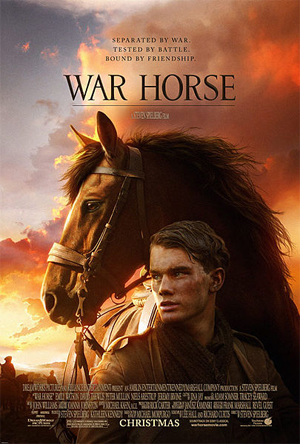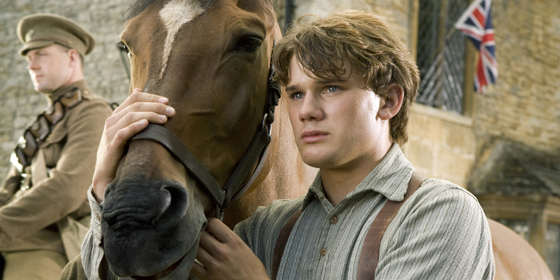Steven Spielberg’s latest film is a simultaneous reminder of his undoubted filmmaking skills and weakness for old-fashioned sentimentality.
Adapted from Michael Morpurgo’s children’s novel – which later became a huge stage hit in London and New York – it follows a young horse named Joey as he gets caught up in World War I.
The resulting equine odyssey we explore his various owners: a Devon farm boy (Jeremy Irvine); an English soldier (Tom Hiddleston); two German troops (David Kross and Leonhard Carow); a French farmer (Niels Arestrup) and the effect he has on the them.
As you might expect from a filmmaker of Spielberg’s vast experience, there are sequences here which are staged with his customary taste and skill.
The rural English locations are beautifully realised through Rick Carter‘s production design and skilfully adapted for the wartime action, which is impressive in scope and detail.
 Perhaps the most impressive aspect of the film is one which audiences may take for granted: the acting and handling of the horses used to represent the title character.
Perhaps the most impressive aspect of the film is one which audiences may take for granted: the acting and handling of the horses used to represent the title character.
Although there are precedents for an animal as lead character – notably Robert Bresson’s Au Hasard, Balthazar (1966) – it is highly unusual to see a mainstream live-action film built around a horse.
The main trainer was Bobby Lovgren and several were used to create the central illusion, which Spielberg pulls off, especially in the latter stages of the film.
Unfortunately, the screenplay by Richard Curtis and Lee Hall appears to have been tailor made for a ‘Spielberg Production’, which means that stilted stereotypical characters and frequent doses of lachrymose sentimentality get in the way of the drama.
By trying to match the ideal of what they think are the directors strengths, the screenwriters have misunderstood that his best work (Jaws, Close Encounters, Schindler’s List and Minority Report) comes when he operates outside his usual comfort zones.
Thus we have an array of great acting talent (Mullan, Watson, Arestrup) along with current casting-director favourites (Hiddleston, Cumberbatch, Kebbell) forced to read awkward lines which undercut the dramatic impact of their scenes.
Visually the film is also mixed bag.
Spielberg and DP Janusz Kaminski are a formidable partnership but here their approach to lighting seems odd.
Filming in the ever-changing climate of England poses challenges for any production, but here the lighting choices are distracting – at times bordering on the avant-garde – with characters faces being lit up like they were on stage.
That being said, the battle scenes are composed with impressive precision and the use of wide-angles and Michael Kahn’s graceful cutting seems like a breath of fresh air in the current era of chaos cinema.
There is also a lot to be said for a film that tries to genuinely appeal to a wide family audience in an era where comic books and animated films rule the multiplexes.
For some – especially those who have had close connections with horses – there are moments that will be undeniably moving, but overall the material doesn’t naturally translate to screen in the manner the filmmakers presumably hoped.
Although the aim here has been to channel the visual style of John Ford on to the battlefields of Europe and to pepper the film with noble anti-war sentiments, the overall effect is underwhelming.
There are frequent touches of brilliance, such as a devastatingly simple shot to conclude a particular battle sequence, but there is little in the way of narrative urgency.
Another negative is the fact that French and German characters don’t speak in their native language – a commercial decision which undercuts the expensively assembled realism of the set-pieces.
The film reaches a nadir of sorts during the final battle when Spielberg reverts to his favoured ‘why can’t we all get along?’ position which feels as predictable as it is redundant, especially when delivered via clunky lines of dialogue.
This is accentuated by the John Williams score which contains all the soaring strings and melodies and beats you might expect – but like the film it is too much surface and not enough substance.
I suspect that there was part of Spielberg that couldn’t resist the lure of War Horse – after the enormous success of the stage production it seemed pre-packaged project for him, with its built-in family appeal and worthy subject matter.
But ever since the beginning of his astonishing career he has been a director who has achieved his very best work in adversity rather than the dangerous comfort zones he finds hard to turn down.
Whether it was the tortuous production of Jaws (1975), the desire for redemption with Raiders of the Lost Ark (1981) after the folly of 1941 (1979), or the compulsion to depict the brutality of the Holocaust in Schindler’s List (1993) after the misfire of Hook (1991) – all these triggered a kind of magic inside of his artistic soul.
For a director who achieved career and financial security so young, the greatest risks have always creative ones and he seems to thrive when making risky leaps of faith.
It was there during his innovative use of the Panaflex camera in The Sugarland Express (1974), his exhilarating framing and cutting during Jaws (1975) and the awesome sights and sounds in Close Encounters of the Third Kind (1977).
As his career progressed, he became so successful as both director and producer that he even reached the giddy heights of owning his own studio, even if it often had to partner with the majors on the big productions.
Yet despite all this ‘extracurricular activity’ he has maintained an impressive focus on his films, even if they have been of varying quality.
War Horse is ultimately not a film that stretched his creative muscles enough.
Perhaps the upcoming Lincoln – a project that he’s been circling for years – could prove to be more challenging?
> War Horse
> Reviews of the film at Metacritic
> Find out more about the book and stage play at Wikipedia
